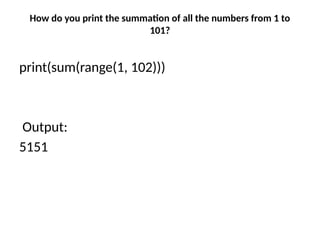PYTHON PROGRAMMING INTERVIEW QUESTIONS.pptx
- 2. 1. Write a simple Python program to print an output. print("Hello, World!")
- 3. 2. Write a Python code to check if a number is even or odd def is_even(num): return num % 2 == 0 print(is_even(4)) # True print(is_even(5)) # False
- 4. Write a Python program to count the number of vowels in a string def count_vowels(s): return sum(1 for char in s if char.lower() in 'aeiou') print(count_vowels("Hello World")) # 3
- 5. Write a Python code to convert a string to an integer str_num = "12345" int_num = int(str_num) print(int_num) # 12345
- 6. Write a Python code to merge two dictionaries dict1 = {'a': 1, 'b': 2} dict2 = {'b': 3, 'c': 4} merged = {**dict1, **dict2} print(merged) #{'a': 1, 'b': 3, 'c': 4}
- 7. Write a Python program to find common elements in two lists list1 = [1, 2, 3, 4] list2 = [3, 4, 5, 6] common = list(set(list1) & set(list2)) print(common) #[3, 4]
- 8. Write a Python code to remove duplicates from a list list1 = [1, 2, 2, 3, 4, 4] unique_list1 = list(set(list1)) print(unique_list1) #[1, 2, 3, 4]
- 9. Write a Python program to find the longest word in a sentence def longest_word(sentence): words = sentence.split() return max(words, key=len) print(longest_word("The fox jumps over the lazy dog")) # jumps
- 10. Write a Python code to find the first non-repeating character in a string def first_non_repeating_char(s): char_count = {} for char in s: char_count[char] = char_count.get(char, 0) + 1 for char in s: if char_count[char] == 1: return char return None print(first_non_repeating_char("nxtwave")) # n
- 11. Write a Python code to implement a binary search algorithm def binary_search(arr, target): low, high = 0, len(arr) – 1 while low <= high: mid = (low + high) // 2 if arr[mid] < target: low = mid + 1 elif arr[mid] > target: high = mid – 1 else: return mid return -1 print(binary_search([1, 2, 3, 4, 5], 3)) # 2
- 12. Write a Python code to implement a function to flatten a nested list def flatten(nested_list): flat_list = [] for item in nested_list: if isinstance(item, list): flat_list.extend(flatten(item)) else: flat_list.append(item) return flat_list print(flatten([1, [2, [3, 4], 5], 6])) # [1, 2, 3, 4, 5, 6]
- 13. Write a Python code to find the maximum subarray sum def max_subarray_sum(arr): max_sum = current_sum = arr[0] for num in arr[1:]: current_sum = max(num, current_sum + num) max_sum = max(max_sum, current_sum) return max_sum print(max_subarray_sum([-2, 1, -3, 4, -1, 2, 1, -5, 4])) # 6
- 14. Write a Python program to find the intersection of two sets def intersection(set1, set2): return set1 & set2 print(intersection({1, 2, 3}, {2, 3, 4})) # {2, 3}
- 15. Write a Python code to implement a simple calculator def calculator(a, b, operation): if operation == 'add': return a + b elif operation == 'subtract': return a - b elif operation == 'multiply': return a * b elif operation == 'divide': return a / b if b != 0 else "Cannot divide by zero" else: return "Invalid operation" print(calculator(5, 3, 'add')) # 8
- 16. Write a Python code to find the GCD of two numbers def gcd(a, b): while b: a, b = b, a % b return a print(gcd(48, 18)) # 6
- 17. Write a Python program to find the largest element in a list. def find_largest(numbers): largest = numbers[0] for num in numbers: if num > largest: largest = num return largest # Test the function nums = [10, 5, 8, 20, 3] largest_num = find_largest(nums) print(f"The largest number is {largest_num}")
- 18. Write a Python program to reverse a string. def reverse_string(string): return string[::-1] # Test the function text = "Hello, World!" reversed_text = reverse_string(text) print(reversed_text)
- 19. Write a Python program to count the frequency of each element in a list. def count_frequency(numbers): frequency = {} for num in numbers: if num in frequency: frequency[num] += 1 else: frequency[num] = 1 return frequency # Test the function nums = [1, 2, 3, 2, 1, 3, 2, 4, 5, 4] frequency_count = count_frequency(nums) print(frequency_count)
- 20. Write a Python program to check if a number is prime. def is_prime(number): if number < 2: return False for i in range(2, int(number**0.5) + 1): if number % i == 0: return False return True # Test the function num = 17 if is_prime(num): print(f"{num} is a prime number") else: print(f"{num} is not a prime number")
- 21. Write a Python program to find the common elements between two lists. def find_common_elements(list1, list2): common_elements = [] for item in list1: if item in list2: common_elements.append(item) return common_elements # Test the function list_a = [1, 2, 3, 4, 5] list_b = [4, 5, 6, 7, 8] common = find_common_elements(list_a, list_b) print(common)
- 22. Write a Python program to sort a list of elements using the bubble sort algorithm. def bubble_sort(elements): n = len(elements) for i in range(n - 1): for j in range(n - i - 1): if elements[j] > elements[j + 1]: elements[j], elements[j + 1] = elements[j + 1], elements[j] # Test the function nums = [5, 2, 8, 1, 9] bubble_sort(nums) print(nums)
- 23. Write a Python program to find the second largest number in a list. def find_second_largest(numbers): largest = float('-inf') second_largest = float('-inf') for num in numbers: if num > largest: second_largest = largest largest = num elif num > second_largest and num != largest: second_largest = num return second_largest # Test the function nums = [10, 5, 8, 20, 3] second_largest_num = find_second_largest(nums) print(f"The second largest number is {second_largest_num}")
- 24. Write a Python program to remove duplicates from a list. def remove_duplicates(numbers): unique_numbers = [] for num in numbers: if num not in unique_numbers: unique_numbers.append(num) return unique_numbers # Test the function nums = [1, 2, 3, 2, 1, 3, 2, 4, 5, 4] unique_nums = remove_duplicates(nums) print(unique_nums)
- 25. Program to find the sum of digits of a given number in Python def sum_digits(num): Sum = 0 for digit in str(num): sum = sum + int(digit) return "Sum of digits :",sum sum_digits(int(input("Enter Number :")))
- 26. Tell the output of the following code: import array a = [4, 6, 8, 3, 1, 7] print(a[-3]) print(a[-5]) print(a[-1]) Output: 3 6 7
- 27. How do you print the summation of all the numbers from 1 to 101? print(sum(range(1, 102))) Output: 5151
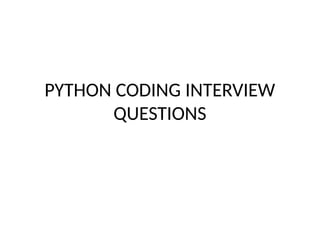
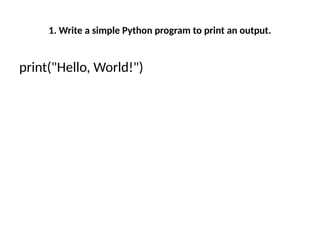
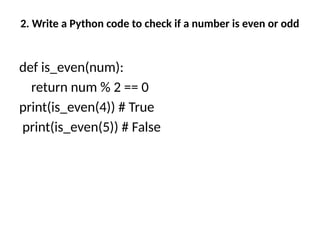
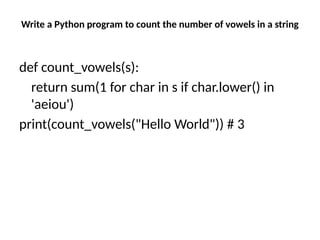
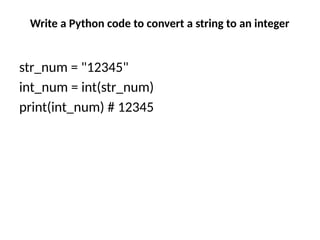

![Write a Python program to find common elements in two lists
list1 = [1, 2, 3, 4]
list2 = [3, 4, 5, 6]
common = list(set(list1) & set(list2))
print(common) #[3, 4]](https://image.slidesharecdn.com/pythonprogramminginterviewquestions-250811054726-de6534b3/85/PYTHON-PROGRAMMING-INTERVIEW-QUESTIONS-pptx-7-320.jpg)
![Write a Python code to remove duplicates from a list
list1 = [1, 2, 2, 3, 4, 4]
unique_list1 = list(set(list1))
print(unique_list1) #[1, 2, 3, 4]](https://image.slidesharecdn.com/pythonprogramminginterviewquestions-250811054726-de6534b3/85/PYTHON-PROGRAMMING-INTERVIEW-QUESTIONS-pptx-8-320.jpg)
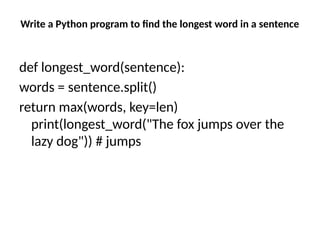
![Write a Python code to find the first non-repeating character in a
string
def first_non_repeating_char(s):
char_count = {}
for char in s:
char_count[char] = char_count.get(char, 0) + 1
for char in s:
if char_count[char] == 1:
return char
return None
print(first_non_repeating_char("nxtwave")) # n](https://image.slidesharecdn.com/pythonprogramminginterviewquestions-250811054726-de6534b3/85/PYTHON-PROGRAMMING-INTERVIEW-QUESTIONS-pptx-10-320.jpg)
![Write a Python code to implement a binary search algorithm
def binary_search(arr, target):
low, high = 0, len(arr) – 1
while low <= high:
mid = (low + high) // 2
if arr[mid] < target:
low = mid + 1
elif arr[mid] > target:
high = mid – 1
else:
return mid
return -1
print(binary_search([1, 2, 3, 4, 5], 3)) # 2](https://image.slidesharecdn.com/pythonprogramminginterviewquestions-250811054726-de6534b3/85/PYTHON-PROGRAMMING-INTERVIEW-QUESTIONS-pptx-11-320.jpg)
![Write a Python code to implement a function to flatten a nested
list
def flatten(nested_list):
flat_list = []
for item in nested_list:
if isinstance(item, list):
flat_list.extend(flatten(item))
else:
flat_list.append(item)
return flat_list
print(flatten([1, [2, [3, 4], 5], 6])) # [1, 2, 3, 4, 5, 6]](https://image.slidesharecdn.com/pythonprogramminginterviewquestions-250811054726-de6534b3/85/PYTHON-PROGRAMMING-INTERVIEW-QUESTIONS-pptx-12-320.jpg)
![Write a Python code to find the maximum subarray sum
def max_subarray_sum(arr):
max_sum = current_sum = arr[0]
for num in arr[1:]:
current_sum = max(num, current_sum + num)
max_sum = max(max_sum, current_sum)
return max_sum
print(max_subarray_sum([-2, 1, -3, 4, -1, 2, 1, -5,
4])) # 6](https://image.slidesharecdn.com/pythonprogramminginterviewquestions-250811054726-de6534b3/85/PYTHON-PROGRAMMING-INTERVIEW-QUESTIONS-pptx-13-320.jpg)

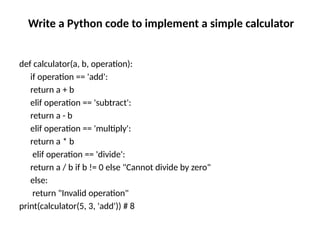
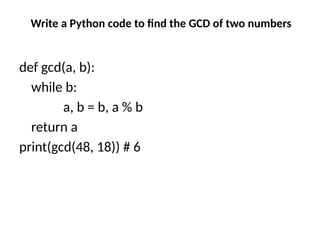
![Write a Python program to find the largest
element in a list.
def find_largest(numbers):
largest = numbers[0]
for num in numbers:
if num > largest:
largest = num
return largest
# Test the function
nums = [10, 5, 8, 20, 3]
largest_num = find_largest(nums)
print(f"The largest number is {largest_num}")](https://image.slidesharecdn.com/pythonprogramminginterviewquestions-250811054726-de6534b3/85/PYTHON-PROGRAMMING-INTERVIEW-QUESTIONS-pptx-17-320.jpg)
![Write a Python program to reverse a string.
def reverse_string(string):
return string[::-1]
# Test the function
text = "Hello, World!"
reversed_text = reverse_string(text)
print(reversed_text)](https://image.slidesharecdn.com/pythonprogramminginterviewquestions-250811054726-de6534b3/85/PYTHON-PROGRAMMING-INTERVIEW-QUESTIONS-pptx-18-320.jpg)
![Write a Python program to count the
frequency of each element in a list.
def count_frequency(numbers):
frequency = {}
for num in numbers:
if num in frequency:
frequency[num] += 1
else:
frequency[num] = 1
return frequency
# Test the function
nums = [1, 2, 3, 2, 1, 3, 2, 4, 5, 4]
frequency_count = count_frequency(nums)
print(frequency_count)](https://image.slidesharecdn.com/pythonprogramminginterviewquestions-250811054726-de6534b3/85/PYTHON-PROGRAMMING-INTERVIEW-QUESTIONS-pptx-19-320.jpg)

![Write a Python program to find the common
elements between two lists.
def find_common_elements(list1, list2):
common_elements = []
for item in list1:
if item in list2:
common_elements.append(item)
return common_elements
# Test the function
list_a = [1, 2, 3, 4, 5]
list_b = [4, 5, 6, 7, 8]
common = find_common_elements(list_a, list_b)
print(common)](https://image.slidesharecdn.com/pythonprogramminginterviewquestions-250811054726-de6534b3/85/PYTHON-PROGRAMMING-INTERVIEW-QUESTIONS-pptx-21-320.jpg)
![Write a Python program to sort a list of
elements using the bubble sort algorithm.
def bubble_sort(elements):
n = len(elements)
for i in range(n - 1):
for j in range(n - i - 1):
if elements[j] > elements[j + 1]:
elements[j], elements[j + 1] = elements[j + 1], elements[j]
# Test the function
nums = [5, 2, 8, 1, 9]
bubble_sort(nums)
print(nums)](https://image.slidesharecdn.com/pythonprogramminginterviewquestions-250811054726-de6534b3/85/PYTHON-PROGRAMMING-INTERVIEW-QUESTIONS-pptx-22-320.jpg)
![Write a Python program to find the second
largest number in a list.
def find_second_largest(numbers):
largest = float('-inf')
second_largest = float('-inf')
for num in numbers:
if num > largest:
second_largest = largest
largest = num
elif num > second_largest and num != largest:
second_largest = num
return second_largest
# Test the function
nums = [10, 5, 8, 20, 3]
second_largest_num = find_second_largest(nums)
print(f"The second largest number is {second_largest_num}")](https://image.slidesharecdn.com/pythonprogramminginterviewquestions-250811054726-de6534b3/85/PYTHON-PROGRAMMING-INTERVIEW-QUESTIONS-pptx-23-320.jpg)
![Write a Python program to remove
duplicates from a list.
def remove_duplicates(numbers):
unique_numbers = []
for num in numbers:
if num not in unique_numbers:
unique_numbers.append(num)
return unique_numbers
# Test the function
nums = [1, 2, 3, 2, 1, 3, 2, 4, 5, 4]
unique_nums = remove_duplicates(nums)
print(unique_nums)](https://image.slidesharecdn.com/pythonprogramminginterviewquestions-250811054726-de6534b3/85/PYTHON-PROGRAMMING-INTERVIEW-QUESTIONS-pptx-24-320.jpg)
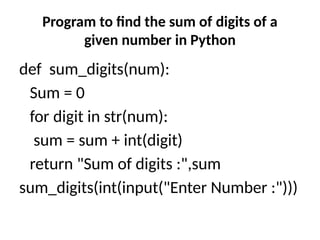
![Tell the output of the following
code:
import array
a = [4, 6, 8, 3, 1, 7]
print(a[-3])
print(a[-5])
print(a[-1])
Output:
3 6 7](https://image.slidesharecdn.com/pythonprogramminginterviewquestions-250811054726-de6534b3/85/PYTHON-PROGRAMMING-INTERVIEW-QUESTIONS-pptx-26-320.jpg)
